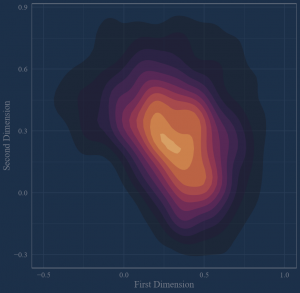Please note: This course will be taught in hybrid mode. Hybrid delivery of courses will include synchronous live sessions during which on campus and online students will be taught simultaneously

Royce Carroll is a Professor in Comparative Politics at the University of Essex. His research focuses on representation and legislative politics, as well as methods to analyse survey and voting data, attitudes, preferences and ideology. He is co-author of the scaling method textbook Analyzing Spatial Models of Choice and Judgment (2nd Ed. 2020), as well as many articles on related methods and applications.
Course Content

This course focuses on methods to discover, understand and visualize latent patterns in data and is especially suited to students with projects using survey data and other forms of relational data used in political science, sociology, economics, business, marketing, and psychology. The course introduces students to measurement theory and methods of scaling techniques, integrating Multidimensional Scaling, Item Response Theory, and Ideal Point Estimation. The first part of the course will provide an overview of the foundations of these techniques and introduce students to the most common methods for scaling and “spatial” analysis and the visualization of latent patterns in survey and behaviour data. Key themes of the course include:
- How can we estimate preferences, traits, and other difficult-to-measure concepts?
- How can we improve comparability of latent concepts across survey respondents, or across separate surveys?
- How can we reduce complex behavioural data to its basic underlying dimensions?
The course will demonstrate how to interpret, measure, and visualize latent dimensions of data via a variety of scaling methods using the open-source programming language R. The course will also discuss a range of applications these methods to social science studies of relational and perception data derived from elite behaviour and surveys, especially for identifying latent preferences of political, economic and social actors. The course concludes with discussions of the most recent advances in the field, including applications for text analysis, and practical advice for those seeking to use such methods in social science research, relevant to the students enrolled.
The course first covers how to analyse data from scales found in surveys (such as Likert-type scales), focusing on surveys that ask respondents to place themselves and / or stimuli on issue or attribute scales. The course begins with approaches to scaling to generate bias-adjusted and latent spatial data from survey responses, such as the Aldrich-McKelvey scaling and ‘Basic Space’ scaling with Anchoring Vignettes as methods for addressing perceptual bias in the form of “Differential Item Functioning.” The course next examines similarities data and rating scale data from surveys (such as favourability scales for stimuli such as politicians or social groups) using multidimensional scaling (MDS), such as the SMACOF optimization method implemented in R and Bayesian applications to Metric Multidimensional Scaling. Finally, the course provides an overview of Item Response Theory and ideal point estimation, generally focused on binary choice data, which includes those used in ‘roll call voting’ analysis of elite behaviour in parliaments and courts. Here we will cover Poole and Rosenthal’s W-NOMINATE and Poole’s Optimal Classification unfolding method, as well as a variety of Bayesian analysis techniques for binary and ordinal choice data using Item Response Theory (IRT). An extensive range of Bayesian techniques is discussed, including Bayesian Aldrich-McKelvey Scaling, Ordinal and Dynamic Item Response Theory, Bayesian Multidimensional Scaling (MDS), and Bayesian Unfolding. The final section will discuss recent methods for scaling to a variety of different data types, including text data and the latest computation innovations to apply scaling methods to large-scale data sets.
This course will enable students to derive latent spatial preference information and/or a dimensional structure from various types of survey and behaviour data, which is applicable to a wide range of social science applications, academic and non-academic alike. Consumers of research based on these methods will also benefit from a deeper understanding of this type of methodology, its potential and its limitations.
Data types covered for scaling, IRT and/or ideal point applications include:
- Survey Response Data, including issue opinions, placements and Likert Scales
- Perceptual, Preferential, and Similarities Data
- Elite behaviour and choice data (e.g., ‘roll call’ voting in legislatures and courts)
- Text Data
Course Objectives
Students will learn to use various computational methods to generate measures of ideology and preferences and understand the latent dimensional properties of social science data, including surveys and legislative data. Students will understand the theories behind these methods and the relationships between Item Response Theory, Ideal Point Estimation and other scaling methods. As these techniques are fundamental parts of much recent work in social science, students will be able to both understand and produce this research based on measuring concepts in this way. In addition, students will be able to:
- Understand the fundamentals of measurement theory and scaling techniques,
- Explain the advantages and limitations of various scaling techniques
- Demonstrate proficiency in using relevant software packages in R
- Identify appropriate methods of measurement for a given set of data.
- Analyse the results of measurement techniques and present them visually.
Course Prerequisites
The course is designed to be accessible to social science graduate students of all backgrounds. However, students familiar with the R programming environment will find it easier to adapt to course content and assignments, so it is recommended to become familiar with the basic structure of the R syntax and the Rstudio software prior to enrolling. The 1-day Introduction to R offered the Sunday before the first day of class at ESS is recommended for this purpose. In addition, the course assumes some basic familiarity with general statistics (OLS and MLE).
Reading:
Armstrong, D. A., Bakker, R., Carroll, R., Hare, C., Poole, K. T., & Rosenthal, H. (2020). Analyzing Spatial Models of Choice and Judgment (2nd ed). : CRC Press ISBN 9780367612542 – (this text will be provided by ESS).
Background knowledge required
Statistics
OLS = elementary
Maximum Likelihood = elementary
Computer Background
R = elementary


